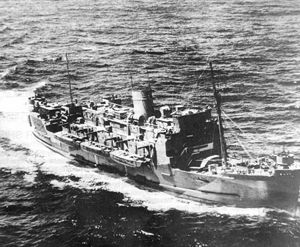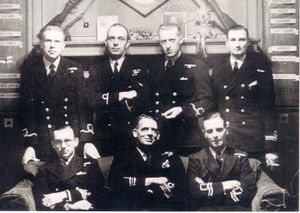HMS Royal Ulsterman

| |
| Career | |
|---|---|
| Name: | HMS Royal Ulsterman |
| Builder: | Harland and Wolff, Belfast |
| Launched: | 10 March 1936 |
| Fate: | Sunk by mine, 1973 |
| General characteristics | |
| Displacement: | 3,250 tons (gross) |
| Length: | 328 feet (100 m) (pp) 339 ft 6 in (103.48 m) (oa) |
| Beam: | 47 ft 9 in (14.55 m) |
| Draught: | 14 ft (4.3 m) |
| Propulsion: | 2-shaft Diesel BHP 7,500 |
| Speed: | 16 knots (30 km/h) |
| Capacity: | 830 troops, six LCAs |
| Complement: | 236 |
| Armament: | 1 x 12 pdr AA, 5 x 20mm AA |
Commissioned in 1936, the Royal Ulsterman was a 3,250 ton passenger ship which, along with her sister-ship, HMS Royal Scotsman, sailed the Glasgow-Belfast run for Burns and Laird Lines Ltd. During the Second World War, Royal Ulsterman served as a Royal Navy Reserve troop transport, taking part in nearly all of the major Allied amphibious operations of the European war, including the Dunkirk evacuation, Operation Neptune, and the liberation of the Channel Islands.
Contents
Wartime Service
Operations off Norway
Commissioned HMS, Royal Ulsterman landed elements of the British Expeditionary Force for operations in Norway in 1940. Subsequently, the ship delivered armaments to Harstad, high above the Arctic circle.
Evacuation of the BEF from France
On 18 June, Royal Ulsterman embarked some 2,800 troops and three civilian women at St. Nazaire, transporting them to Falmouth. By the end of August, she had also transported French personnel to Casablanca, carried civilian refugees from the Mediterranean region to Glasgow, and landed some 700 troops at Iceland. Over the next year, Ulsterman would make regular trips between the British Isles and Iceland. During one of these runs, Ulsterman carried the three survivors of HMS Hood back to the UK.
On 29 August 1941, off the west coast of Scotland, Ulsterman was holed in a collision with the destroyer HMS St. Mary's, requiring repairs on the Mersey until late September.
Operation Torch
Ulsterman took part in Operation Torch, landing United States Army Rangers of the 1st Battalion on the Algerian coast on 8 November 1942. On 14 November, while ferrying troops from Oran to Algiers, Ulsterman was attacked, unsuccessfully, by five Luftwaffe aircraft.
Operation Husky and Operation Avalanche
On 10 July 1943, Royal Ulsterman disembarked troops of the British 8th Army in Sicily for Operation Husky. She subsequently took part in Operation Avalanche, landing troops on 9 September 1943 at Salerno.
Operation Neptune
After a two-month long refit at Southampton in March and April 1944, Royal Ulsterman took part in Operation Neptune, the amphibious operation that launched Operation Overlord, the Allied invasion of Normandy on 6 June 1944. Ulsterman disembarked troops of the 9th brigade of the 3rd Canadian Infantry Division to Juno Beach.
Liberation of the Channel Islands
Seized by the Germans in 1940, the Channel Islands were the only part of the British Isles to be occupied by the enemy during the Second World War. Not until after Germany's surrender were the islands liberated. Royal Ulsterman landed British troops on Jersey on 11 May 1945 and provided additional reinforcements on 18 May.
Postwar History
Royal Ulsterman returned to Belfast in November 1945 and was paid off on 20 December. After reconditioning, she resumed work on the Glasgow-Belfast run for Burns and Laird. She served in this capacity until 1967. Serving with Mediterranean Link Lines of Famagusta in 1973, she struck a mine near Beirut and sank.
References
- Lenton, H.T. & Colledge, J. J. Warships of World War II, Ian Allen, London, 1973. ISBN 0-7110-0403-X

